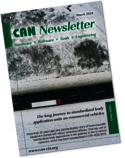
No. 5 - March 28, 2024
A word from the CiA Managing Director

CAN FD is well established in the automotive industry. Many automakers have migrated from CAN CC (classic) networks to CAN FD. Other industries have started to use CAN FD, too. There are two reasons to do so: the larger data field (up to 64 byte) and the higher bit rate in the data phase. When the user only wants to benefit from the larger payload, the nominal bit rate and the data(phase) bit rate can be the same. You can achieve this by configuring only the nominal bit rate and not setting the BRS (bit rate switch) bit. Theoretically, you could configure both bit rates to the same value (e.g. 500 kbit/s) and set the BRS bit. To avoid any issues linked to bit rate switching and available bit timing register sizes, CiA recommends in these cases not to use the bit rate switching. Pay attention: Even if you do not intend to use the bit rate switching, initializing the bit timing registers for the data phase, with a suitable data phase bit rate can be beneficial. Implementations of CAN FD tools or devices may demand CAN FD usage with BRS. A network wide, suitable data phase bit rate setting in all devices, even if they are just temporarily connected, would avoid severe CAN error scenarios and would increase the robustness of your network.
Using CAN FD at low speed allows you to benefit from the large CAN FD data field and at the same time to support complex network topologies, with large network dimensions. Thus, requirements for embedded control networks used in e.g. lift applications, construction machineries, trains, or even cargo ships, can be met. Using the same bit rate in arbitration phase and data phase may put unacceptable latencies to your network. To avoid these latencies, a system designer could intend to switch e.g. from 125 kbit/s in arbitration phase to 500 kbit/s in the data phase. In theory, this should work. Practical experience has shown that several CAN FD controller implementations do not support an appropriate size in the bit timing registers, for adjusting this kind of bit rate combinations. This applies in particular, in case you want to achieve a bit timing stetting that results in robust network behavior and follows the rules for CAN FD node and system design, provided in CiA 601-2; available on the CiA website.
As several CiA members have been faced with these challenges, CiA has started to work on recommend bit timing settings for CAN FD networks, using very low bit rate combinations (e.g. 500 kbit/s, 250 kbit/s, and 125 kbit/s) in arbitration and data phase. The intent is to support device developers in their objective of providing interoperable products. System designers are assisted in setting up a robust CAN system. Finally, also semiconductor manufacturers get useful hints, which bit rate combinations are required in the field – e.g. based on the topology and cabling requirements.
The initiative is currently managed by the CiA IG02 CANopen FD. In case you like to join the initiative, please contact CiA office.
p.p. Reiner Zitzmann
General manager CAN in Automation GmbH
CiA 401-1 and CiA 401-2 are publicly available
The two-part CANopen CC (classic) profile specification (version 3.1.0) for modular I/O devices has been released as Public Available Specification (PAS). Thus, CiA 401-1 and CiA 401-2 can be downloaded free of charge from the CiA website. Part 2 contains the specification for joysticks.
Call for experts: CANopen embedding in OPC-UA
The JTF01 OPC-UA within the CiA IG CANopen is a joint working group of the OPC Foundation and CAN in Automation. It has been established for specification of profiles for embedding CANopen in the world of OPC UA. The group has already created a document proposal, which defines an OPC UA Information Model to represent the CANopen models.
CiA is looking for member companies, who would like to proceed with the work on the intended specification. Please indicate your interest to secretary(at)can-cia.org by April 24, 2024.
Visit CiA at Embedded World 2024
CiA is exhibiting at the trade show from April 9 to 11, on the stand 203 in hall 1. Here, you can get the latest information on any CAN-related topic, talk with CAN experts, and take a look on the current CAN(open) products from different companies on the CiA panel walls.
Interested parties are welcome to schedule a meeting with a CiA employee in advance.
CiA posters: Overview on CANopen CC and CANopen FD
The clearly structured DIN A1 wall posters provide important technical details on CANopen CC (classic) and CANopen FD and are distributed on trade shows and events participated by CiA.
The posters provide spaces for advertisements available for CiA members only. To book an advertisement, interested parties should complete and sign the order form and return it to CiA by April 22, 2024.
CAN Newsletter magazine
The March magazine issue is the first CAN Newsletter edition with re-integrated CAN Newsletter Online. There are technical in-depth articles, overview-style articles, and compact brief news about some recent products.
The issue provides three articles about automated guided vehicles (AGVs) and autonomous mobile robots (AMRs). These are ‘Learning platform for AMRs and AGVs‘ by Faulhaber, ‘Autonomous mobile robots in warehouses’ from Dunkermotoren, and ‘CANopen freeds AI’ written by CiA. The latter comprises an overview on products (e.g. drives and sensors) exhibited on the SPS 2023 fair, which are used in AGVs and AMRs. The article is complemented by the according background information.
New video on Youtube
CiA activities
- CiA education and information events
- Upcoming meetings (only for members)
New CiA members since the last CCN
- ChargePoint (GB)
- EWM (DE)
- Gunda Automation (DE)
- Silvaco (US)
CiA has 751 members (March 28, 2024)
CiA Product Guides
Editors: Olga Fischer, Holger Zeltwanger (responsible according to the press law)
Advertising: Birgit Ruedel (responsible according to the press law)
CAN in Automation (CiA) e. V.
Kontumazgarten 3
90429 Nuremberg (Germany)
Tel. +49-911-928819-0
www.can-cia.org
AG Nuremberg VR 200497
CAN Community News sign up
This 3-weekly free-of-charge email service provides CAN-related news to the entire CAN community. This includes reports about CiA activities, released CiA documents, available CiA publications, and other topics.
If you would like to subscribe to the CAN Community News please send an e-mail to mail(at)can-cia.org.
